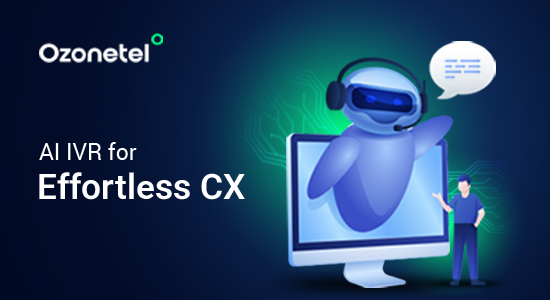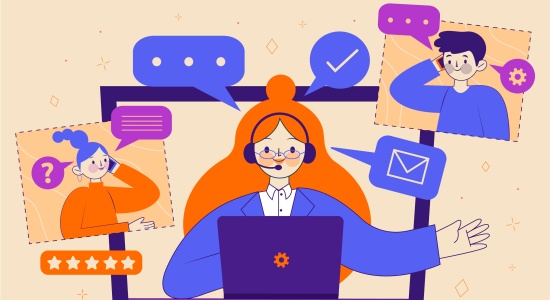- Resources
- Generative AI for Customer Service: A Complete Guide
Generative AI for Customer Service: A Complete Guide

Generative AI is a technology that allows machines to create content, such as text or speech, by learning from existing data. In the context of customer service, it can be used to automate and improve interactions with customers. You can use it for tasks like answering questions, solving problems, or even assisting with more complex issues.
With Gen AI handling repetitive tasks, human agents can focus on more complicated matters, resulting in faster service and improved customer satisfaction. In this article, we talk more about how Gen AI can impact customer service. Read along!
What Is Customer Obsession?
Customer obsession is about placing your customers at the core of every decision you make. It goes beyond simply satisfying their needs—it’s about actively working to improve their experience at every touchpoint, anticipating what they want, and addressing their concerns before they even raise them.
Generative AI Meaning
Generative AI refers to artificial intelligence that can create new content, including text, images, audio, and even video through tools like an AI video generator. Unlike traditional AI, which follows predefined rules, generative AI learns patterns from large datasets and produces responses that feel human-like.
What is Generative AI for Customer Service
Generative AI in customer service refers to the use of artificial intelligence to create human-like responses to customer inquiries. Unlike traditional customer service systems that rely on pre-programmed responses, generative AI can generate answers in real-time, tailored to the specific needs of the customer. It can create content such as text, speech, and even images, making customer interactions smoother and more personalized.
The core technology behind generative AI in customer service includes:
- Natural Language Processing (NLP) allows AI to understand and interpret the words customers use. It helps the AI know what the customer is asking, even if they don’t phrase it exactly the same way each time.
- Machine Learning (ML) helps the AI improve over time. It learns from previous interactions and adjusts its responses accordingly, getting more accurate as it gains more data.
How to Implement Generative AI in Customer Support
Implementing generative AI in your customer support can significantly improve efficiency, speed, and customer satisfaction. However, setting it up requires careful planning. Here’s a step-by-step guide on how to get started:
1. Define Clear Objectives
Before diving into the technical side, clarify what you want to achieve with AI. Do you want to improve response times, reduce the workload on human agents, or enhance personalization? Knowing your goals will help you choose the right AI tools and set measurable targets. For instance, if your goal is to cut response times, you may need an AI-driven chatbot that can handle simple inquiries and triage complex issues.
2. Choose the Right AI Tools
Select an AI tool that suits your customer support needs. Look for platforms that offer generative AI features like chatbots, automated ticket handling, and AI-powered voice assistants. Some tools also offer natural language processing (NLP), which helps AI understand and respond to customer queries in a human-like manner. Make sure the platform you choose integrates well with your existing customer support software, such as your helpdesk or CRM (customer relationship management) systems.
3. Train the AI System
Generative AI learns from existing data to respond accurately to customer inquiries. For effective implementation, you’ll need to feed it with relevant historical customer service data, such as past conversations, FAQs, and product documentation. This will help the AI understand the language, tone, and context of customer queries. The more high-quality data you provide, the better your AI will perform. It’s also crucial to continuously train the system, especially as your business or customer base grows.
4. Set Up Automated Workflows
Once you’ve chosen an AI tool and trained it, set up automated workflows. These workflows define how the AI should interact with customers. For example, if a customer asks a common question, the AI can automatically pull up a relevant answer from your knowledge base. If the issue requires a human response, the AI can escalate the query to the right support agent. Automating these workflows reduces manual intervention and speeds up the entire process.
5. Test the AI System
Before going live, test the AI system thoroughly. Run simulations to see how the AI responds to different customer queries. Make sure the system is generating accurate and helpful responses. Also, check how the AI handles complex cases and whether it can seamlessly hand over to a human agent when needed. Test with various customer scenarios to identify any gaps or areas where the AI might need adjustments.
6. Monitor and Optimize
After implementing AI, you must keep an eye on how it performs. Monitor metrics like response time, customer satisfaction, and resolution rate. AI is not perfect at first, and it’s likely to make mistakes, especially with less common queries. Use feedback from customers and support agents to improve the system. Regularly review and update the AI’s knowledge base and workflows to keep it accurate and relevant.
7. Provide Hybrid Support Options
While AI can handle many routine inquiries, human agents are still essential for complex or sensitive issues. Set up a hybrid system where customers can easily switch between AI and human agents. For example, if the AI cannot solve a problem, it should be able to transfer the issue to a human representative. Having this balance ensures that customers always get the right level of support.
8. Train Your Team
Your customer service team will need to adapt to working alongside AI. Train your agents on how to use AI tools, including how to monitor AI interactions and intervene when needed. Agents should also understand how AI handles queries so they can better assist with any escalations. This collaboration between AI and human agents will create a seamless experience for customers.
9. Ensure Data Privacy and Security
When implementing generative AI, make sure to address data privacy and security concerns. Ensure that AI platforms comply with privacy regulations, like GDPR (General Data Protection Regulation) if you’re operating in the European Union (EU) or California Consumer Privacy Act (CCPA) in the U.S. AI will handle sensitive customer data, so it’s crucial to have strict data protection measures in place.
10.Gather Feedback and Iterate
After the system is up and running, collect feedback from customers and support agents. Use this feedback to make improvements to your AI system, whether it’s enhancing response accuracy, expanding the knowledge base, or optimizing workflows. Continuous iteration will ensure that your generative AI solution remains effective and aligned with customer needs.
5 Use Cases of Generative AI in Customer Service
Generative AI is becoming increasingly important in customer service, providing multiple ways to improve efficiency and customer satisfaction. Here are five practical use cases where generative AI can make a difference:
Sentiment Analysis
Generative AI analyzes customer feedback—such as emails, chat transcripts, and social media mentions—to detect sentiment (positive, negative, or neutral). It also identifies subtle emotional cues to help agents adjust their tone. For instance, if a customer expresses frustration, AI can suggest a more empathetic response, ensuring a better experience.
Enhance Agent Productivity
Generative AI acts as an assistant, providing agents with real-time response suggestions, summarizing conversations, and retrieving relevant information. Instead of manually searching for answers, agents receive AI-generated responses based on company policies and previous interactions.
This reduces handling time and improves first-contact resolution (resolving issues in the first interaction). AI can also categorize and prioritize customer requests, ensuring that urgent issues get immediate attention.
Agent Training and Quality Assurance
AI-driven training tools analyze past customer interactions and provide personalized feedback to agents. It scores conversations based on response accuracy, resolution efficiency, and customer satisfaction.
Managers can use these insights to coach agents on handling difficult situations more effectively. AI can also monitor live calls and chats, flagging potential compliance risks or service gaps for immediate correction.
Chatbot Training For Elevated Support
Traditional chatbots rely on predefined scripts, but generative AI-powered chatbots can engage in natural conversations and handle complex queries. They pull data from knowledge bases, customer profiles, and live databases to provide personalized support.
For example, if a customer wants to modify a flight itinerary, the chatbot can adjust dates, seat preferences, and meal options while confirming changes in real-time. Over time, AI continuously learns from interactions to improve accuracy and reduce repetitive customer escalations.
Root Cause Analysis
AI helps identify recurring customer issues by analyzing patterns in service tickets, chat logs, and feedback. Instead of addressing symptoms, businesses can resolve the underlying problem.
For example, if multiple customers report billing errors, AI can pinpoint the common factor—such as an issue with a payment gateway or subscription settings. This allows businesses to fix systemic problems before they escalate.
Benefits of Implementing Generative AI in Customer Service
Implementing generative AI in customer service can provide several benefits that not only improve the experience for customers but also optimize the internal workflow of your support team. Here’s how you can benefit:
Improved Customer Satisfaction
With generative AI, customers no longer have to wait long periods to get answers to their queries. AI-powered systems like chatbots or virtual assistants can provide instant responses, which is especially valuable for simple or frequently asked questions.
The AI understands the intent behind customer inquiries and can generate appropriate, accurate responses. This leads to faster problem resolution and less frustration for customers, improving their satisfaction and loyalty to your brand. AI’s ability to understand language variations ensures customers can communicate naturally, further enhancing the experience.
Cost Efficiency
AI can manage a significant portion of customer inquiries, particularly the repetitive and basic ones, which would otherwise require human agents to handle. This helps reduce the number of agents needed for those tasks, lowering labor costs.
Moreover, AI systems can handle a high volume of requests simultaneously, meaning you don’t have to scale your team at the same rate as your customer base grows. Smaller teams can be allocated to more complex tasks, which leads to better resource management and cost savings in the long term.
Consistency in Responses
Generative AI ensures that customers receive accurate and consistent information each time they interact with your support system. Human agents can sometimes offer varying answers depending on mood, workload, or knowledge gaps, but AI follows preset rules and protocols, providing the same response to similar queries every time.
This ensures uniformity and reliability in your customer service operations. It also builds trust with customers because they know they will get the same level of service, no matter when or how they reach out. For example, if a customer asks about shipping policies, AI will provide the same clear and accurate answer consistently across different touchpoints, whether via chat, email, or phone.
Scalability
As your business grows, the volume of customer queries will likely increase. While scaling up a human customer service team requires significant investment in hiring and training, generative AI can handle increased demand without additional resources.
Unlike human staff, AI can simultaneously manage thousands of inquiries, maintaining speed and efficiency even as demand rises. This scalability ensures your customer service can handle growth without sacrificing quality.
Personalized Customer Interactions
Generative AI has the ability to remember past interactions with customers and use that information to personalize future conversations. For example, if a customer frequently asks about the status of their order or has a history of returning items, AI can provide tailored responses based on that data, offering proactive solutions or recommendations.
Personalization goes beyond just remembering names—it’s about understanding each customer’s unique needs and offering them solutions that feel relevant. This level of personalization can create stronger customer relationships and drive repeat business because customers feel valued and understood.
Availability Around the Clock
With Gen AI, customers from different time zones or those who need help outside regular working hours can still get immediate responses. This round-the-clock availability ensures your business is accessible at all times, improving convenience for your customers.
For example, if you run an online store, customers in different time zones can get support at any hour, whether they need help with a purchase or a post-purchase query. Having AI work continuously means no downtime, giving your customers the help they need whenever they need it.
Faster Resolution of Issues
Generative AI can process and retrieve information quickly, allowing it to resolve customer issues faster than a human agent might. AI systems can suggest troubleshooting steps, direct customers to relevant articles, or even handle basic technical support issues without waiting for human intervention.
If a customer needs help with a product feature, AI can instantly provide instructions or links to relevant resources. AI’s ability to understand and generate helpful content on demand leads to faster resolutions, which directly impacts customer satisfaction and reduces wait times. This can be particularly helpful in industries with complex products or services that often require quick solutions.
How Ozonetel Can Help
Generative AI powers tools like chatbots, virtual assistants, and automated email systems that handle customer support tasks. These tools can provide quick answers to frequently asked questions, resolve common issues, and route more complex queries to human agents. The result is faster service, higher customer satisfaction, and reduced workloads for customer service teams.
Moreover, tools such as Ozonetel leverage Generative AI to provide an array of tools designed to improve customer service efficiency and enhance customer experience (CX) across various channels.
Ozonetel’s platform offers AI-powered solutions like chatbots, virtual assistants, and automated email systems, which help handle customer support tasks. These tools can quickly answer common questions, resolve recurring issues, and route more complex queries to human agents. As a result, you can streamline operations, provide faster service, and ensure higher customer satisfaction, all while reducing the workload of your support teams.
Speak to our digital expert now!
Conclusion
A customer-centric business thrives on delivering seamless, personalized experiences across every touchpoint. This is where AI-driven solutions like Ozonetel’s oneCXi come in—helping enterprises engage, convert, and retain customers with precision.
With AI-engineered tools such as CXi Agents, businesses can automate workflows, analyze conversations in real time, and integrate effortlessly with existing platforms. This streamlines operations and makes sure that every customer interaction is meaningful and value-driven.
As brands increasingly prioritize customer-centricity, using AI-driven platforms like oneCXi becomes important to deliver cohesive experiences, understand customer needs, and maximize lifetime value.
Upgrade Your Customer Service with Generative AI
Frequently Asked Questions
The 10 types of customers include:
- Potential Customers
- New Customers
- Confused Buyers
- Loyal Customers
- Angry Customers
- Lapsed Customers
- Need-based Customers
- Referring Customers
- Discount-Seeking Customers
- Curious Customers
The four primary types of customers are:
- New Customers – those trying your product or service for the first time.
- Returning Customers – familiar with your brand and come back for more.
- Loyal Customers – repeat buyers who trust your brand.
- Discount Customers – attracted mainly by deals or offers.
A customer is an individual or entity that purchases goods or services from a business. Customers are essential to a business’s success, as their needs and satisfaction drive growth and sales.







